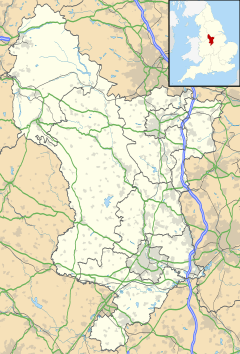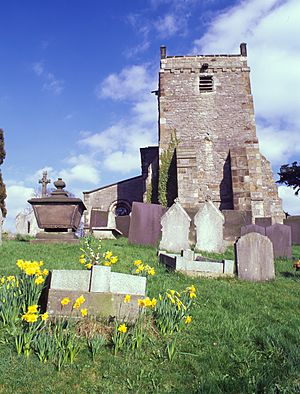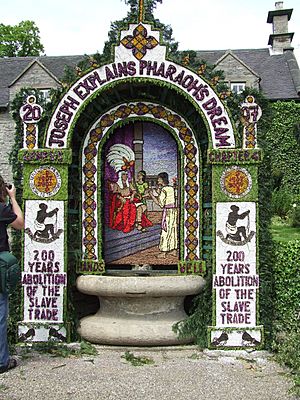Tissington facts for kids
Quick facts for kids Tissington |
|
|---|---|
 Tissington Pond |
|
| Population | 158 (2001) |
| OS grid reference | SK176523 |
| Civil parish |
|
| District |
|
| Shire county | |
| Region | |
| Country | England |
| Sovereign state | United Kingdom |
| Post town | ASHBOURNE |
| Postcode district | DE6 |
| Dialling code | 01335 |
| Police | Derbyshire |
| Fire | Derbyshire |
| Ambulance | East Midlands |
| EU Parliament | East Midlands |
| UK Parliament |
|
Tissington is a small, pretty village in Derbyshire, England. It is known for its beautiful old buildings and a special tradition called well dressing. The village has been owned by the FitzHerbert family for a very long time, since 1465. Many people visit Tissington, especially during its well dressing week. You can also enjoy walking or cycling on the Tissington Trail nearby. Another path, the Limestone Way, goes right through the village.
Contents
A Look Back at Tissington's History
How Old is Tissington?
Tissington is a very old village. It was first written about in a famous book called the Domesday Book in 1086. At that time, it was called Tizinctun. The King gave the land to a person named Henry de Ferrers. The book described the land, how many farms it had, and its value.
The FitzHerbert Family's Long Connection
Later, during the time of King Henry I, the land passed to the Savage family. In 1259, the last male heir, William le Savage, died. The estate was then split between two families: the Meynells and the Edensors.
In the 1460s, Nicholas FitzHerbert married into the Meynell family. This is how the FitzHerbert family first got part of the estate. Later, during the reign of Queen Elizabeth I, Francis FitzHerbert bought the rest of the land from the Edensors' heirs. Since then, the FitzHerbert family has owned the entire village and its lands.
Tissington During the Civil War
During the English Civil War, a special fort was built on a hill north of the church. This fort, called a redoubt, is now a protected historical site. In December 1643, Tissington Hall was used as a base for King Charles I's soldiers. Colonel Fitzherbert, the owner, was in charge of it.
Tissington Today
As of 2021, Sir Richard FitzHerbert, 9th Baronet owns the village. He has owned it since 1989 and lives at Tissington Hall. He shared that 45 of the village's homes are rented out. Also, tenants farm the 2,000 acres of land around the Hall. The Hall itself is sometimes used for events like weddings.
On April 1, 2009, Tissington village joined with Lea Hall. They now form one combined area called "Tissington & Lea Hall".
Famous Buildings in Tissington
Tissington Hall
Right in the middle of the village is Tissington Hall. This is the main home of the FitzHerbert family. It is a beautiful Jacobean style building. It was built in 1609 by Francis FitzHerbert. It replaced an older house that had a moat around it. Tissington Hall is a very important historic building. In 2006, the owner received a special award for managing the estate well.
St Mary's Church
Across from the Hall is the parish church of St Mary. It has a Norman style tower and a special bowl for baptisms, called a font. People believe the font shows a scene from the story of Saint Beorhthelm of Stafford.
Village Cottages
Most of the other buildings in Tissington are built in a local style. This style uses materials and designs common to the area. About 70% of these buildings are also listed as historic.
The Tradition of Well Dressings
Every year, around 50,000 people visit Tissington to see its famous well dressings. Six wells in the village are decorated. These are Children's Well, Coffin Well, Hall Well, Hands Well, Town Well, and Yew Tree Well.
The decorations are made during the week of Ascension Sunday. Artists create pictures by pressing flower petals and other natural materials into a soft clay base. The pictures often show stories from the Bible. They might also show important events or anniversaries from the year.
This tradition is thought to have started a very long time ago, possibly in 1348. Villagers believed that the pure water from their wells saved them from the terrible disease called the Black Death. They decorated the wells to thank God for keeping them safe.
Literary Connections
The writer Richard Graves wrote parts of his novel The Spiritual Quixote while he was staying in Tissington.






